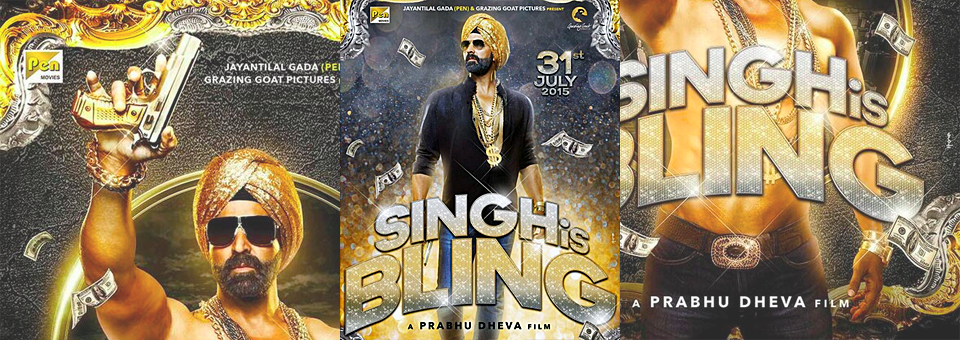The promotional poster of a new Bollywood film titled ‘Singh is Bling’ was shared through social media over the weekend to equal joy and disgust. The central image showcases a Sardar adorning a shimmering gold turban, giant shades and an array of waist-length gold chains, including one featuring an oversized dollar medallion. Holding a gun in his right hand, he is set onto an equally gawdy dark background as dollar-notes float and fall around him. Much has been written and said about Bollywood’s fascination with lampooning the Sikh character, but what of this more recent trend to commercialise Sardars as testosterone-fuelled and money-orientated?
Slated for release in the summer of 2015, ‘Singh is Bling’ is set to star well known actor Akshay Kumar and is being produced by his joint-venture film production house GrazingGoat Pictures; the director is the noted South Indian choreographer and actor, Prabhudheva. The promotional poster, or rather two derivatives of it were shared by the official Twitter account of the production company asking followers which one they preferred. A number of replies and retweets didn’t indicate that there might be any problem with the film at all, largely coming from South Asians and Bollywood film enthusiasts; instead the conversation focused on gushing wildly about a film that hasn’t cast its leading actress yet and answering the question posed – which poster was preferred. An altogether different conversation can be found though elsewhere on twitter where the likes of Youtuber Jus Reign led the sheer bewilderment with which a poster of this type should be met.
I meet a few people from time to time who question why Sikhs such as myself get annoyed or upset by the way we are depicted by the Bollywood film industry. “We are being too sensitive“, I’m told or, “the producers are reflecting real life characters who exist” I’m patronisingly informed. Specious reasoning when it comes to the latter – are we expected to believe that the only Sikhs who Bollywood producers meet are members of RDB or Daler Mehndi? (Actually that might be true which is even more worrying for them!)
It is reflective of modern India and indeed the wider South Asian region that different communities are represented in film as a certain calibre of person, stereotyped in a way that should be troubling to a mature and cultured mind. For so long Sikhs were depicted as jokers, drunken oafs and providers of light-hearted entertainment; in recent years that typecast has been added to with brutish, testosterone-filled profiteers – characters who are meant to portray heroes, but do just as much harm to the more comprehensive image of Sikhs. It is not that these are the characters who Sikhs are portrayed as in Bollywood, but that they are the ONLY Sikh characters we see. It fits within the larger context of an India that treats minorities as second class citizens and does not accord to them the identity’s that they demand. Considering that Sikhs remain unrecognised as a distinct group in the Indian Constitution, is it really so hard to see why we might be so sensitive to Bollywood’s portrayal of us?
‘Singh is Bling’ is billed as the follow-up to ‘Singh is King’ which was a hit for Kumar in 2008. Little wonder then that the hashtag #singhisbling was trending in India on Sunday and is doing the same in the US today (Monday). Perhaps the only recourse to redefining the Sikh character on film is to create cinematic productions of a similar level that tell a different story – not easily done considering the limited budgets at the disposal of Sikh film-makers such as myself. But if truth be told, it’s still far more likely to bring about a balance than speaking out against the Bollywood bandwagon. ‘Singh is Bling’ is scheduled to be on worlwide release in July 2015; I won’t be going and I hope you won’t too.






